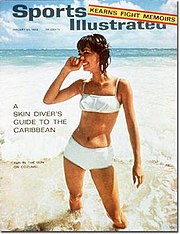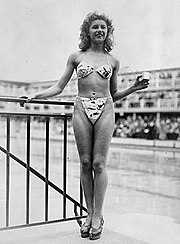Throughout its history, the bikini has spawned many stylistic variations. Topless variations may still be considered bikinis, although technically no longer two-piece swimsuits. A regular bikini (i.e. not a variant) is defined as a two pieces of garments that cover the groin and buttocks at the lower end and the breasts in the upper end. Skimpier styles have narrow sides, including V-cut (in front), French cut (with high-cut sides) and low-cut string (with string sides). Other styles include a bandeau top - a rectangular strip of fabric covering the breasts, a top with cups similar to a push-up bra, and more modest bottom pieces such as briefs, shorts, or briefs with a small skirt attached.[16]
Bikini underwear is a type of undergarment worn by both men and women that is similar in size and revealing nature to the bottom half of a bikini bathing suit, popular among women. For women a bikini can refer to virtually any tight, skimpy, or revealing undergarment that provides less coverage to the midsection than traditional underwear, panties or knickers. For men, a bikini is a type of undergarment that is smaller and more revealing than men's briefs. Sometimes the term bikini is used to describe the type of man's swimsuit also known as a speedo although men's bikini swimsuits do exist that are not brief like. Men's bikinis can have both high or low side panels and normally rest lower than the true waist or at the upper hips. Most men's bikinis lack a button or flap front. Many do not have a visible waistband like briefs.
String bikini
A string bikini refers to a bikini swimsuit that is scantier and more revealing than traditional bikinis. It gets its name from the string characteristics of its design. Rather than featuring a full single piece bottom, the string bikini consists of two triangular shaped pieces connected at the groin but not at the sides, where a thin "string" wraps around the waist connecting the two parts. String bikini tops are similar and are tied in place by the attached "string" pieces. String pieces can either be continuous or tied.
It is claimed that Brazilian fashion model Rose de Primo created the first string bikini when she had to sew one with insufficient fabric available to her for a photoshoot. The first formal presentation of string bikini was done by Glen Tororich, a public relations agent, and his wife Brandi Perret-DuJon, a fashion model, for the opening of Le Petite Centre, a shopping area in the French Quarter of the New Orleans, Louisiana in 1974. Inspired by a picture of a Rio De Janeiro fashion model in an issue of Women's Wear Daily, they had local fashion designer Lapin create a string bikini for the event. Models recruited by talent agent Peter Dasigner presented it by removing fur coats by Alberto Lemon on stage. The presentation was covered by local television stations and the New Orleans Times-Picayune newspaper, and was sent out via the wire news services of the Associated Press and United Press International.
String bikinis are one of the most popular variations of traditional bikinis.[citation needed] A string bikini or thong is also a type of undergarment worn by both men and women. It is similar to but more revealing than a bikini. Women's string bikini underwear normally resembles the bottom of the string bikini bathing suit. Men's string bikini underwear consists of a front and rear section joined at the crotch but not at the sides. The tops of each piece join with either an elastic waistband similar to that found on briefs or to a thin piece of material or "string," leaving the sides exposed except for the string or waistband.
Monokini
Monokini, sometimes referred to as a unikini, is a woman's one piece beach garment equivalent to the lower half of a bikini.[17] The term is used for different styles of one-piece swimsuits inspired by the bikini.
In 1964, Rudi Gernreich, an Austrian fashion designer, designed the original monokini in the US.[18] Gernreich also invented its name, and the word monokini is first recorded in English that year. Gernreich's monokini looked like a one-piece swimsuit but cut off a bit below the breasts leaving them bare. It had only two small straps over the shoulders. It was not very successful. Many women who wanted to sunbathe topless simply wore the bottom part of a bikini. Manufacturers and retailers quickly adapted to selling tops and bottoms separately. Gernreich later created the lesser known pubikini.[19]
In the 1960s, the monokini led the way into the sexual revolution by emphasizing a woman's personal freedom of dress, even when her attire was provocative and exposed more skin than had been the norm during the more conservative 1950s. Today, many monokinis are designed as the ultimate in sexy swimwear, using chains, strings, and strategic strips of fabric to join the upper and lower portions of the suit while still covering the basics of the female form. Today's styles are decidedly less racy than Gernreich's original design, but nonetheless are a revealing style of swimsuit.[20]
The term monokini is also now used to indicate any topless swimsuit,[21] particularly a bikini bottom worn without a bikini top.[22][23] In recent years, the term has come into use for topless bathing by women: where the bikini has two parts, the monokini is the lower part. Where monokinis are in use, the word bikini may jokingly refer to a two-piece outfit consisting of a monokini and a sun hat.
Microkini

A stick-on style of Microkini attaches with adhesive.
A microkini is an extremely skimpy form of a bikini. The designs for both women and men typically use only enough fabric to cover the genitalia. Any additional straps are merely to keep the garment attached to the wearer's body. Some variations of the microkini use adhesive or wire to hold the fabric in place over the genitals. These designs do not require any additional side straps to keep the garment in place. The most radical variations of the microkini are simply thin straps which cover little or none of the wearer's body. The term "microkini" was coined in 1995 in an online community dedicated to enthusiasts of the extreme designs.[24][25] Microkinis fill a niche between nudism and conservative swimwear. In addition to keeping the wearer just within legal limits of decency, they have also evolved to become the ultimate in provocative sun wear.
The modern microkini's origins can be traced back to the early-1970's in Venice Beach, California, USA, where, after legislation was passed banning nudity there, beach regulars began making their own tiny bathing suits to comply with the new laws. The homemade suits were often little more than tiny, remnant pieces of fabric, crudely sewn together with thin twine or fishing line. Then around 1975, a local bikini shop picked up on the idea and began to make more practical styles using modern materials. Soon after, several adult film actresses began wearing the shop's suits in their films and the style began to catch on.[citation needed] Pubikini, an extreme form of microkini, is another bathing suit created by Rudi Gernreich. The pubikini is a small piece of fabric that hugs the hips and buttocks but leaves the pubic region exposed.[19]
Tankini
The tankini is a swimsuit combining a tank top and a bikini bottom.[26] The tankini is distinguished from the classic bikini by the difference in tops, the top of the tankini essentially being a tank top. The tankini top extends downward to somewhere between just above the navel and the top of the hips. The word is a neologism combining the tank of tank top with the end of the word bikini.
This type of swimwear is considered by some to provide modesty closer to a one piece suit with the convenience of a two piece suit, e.g. the entire suit need not be removed in order to use a lavatory. Tankinis come in a variety of styles, colors and shapes, some include features such as integrated push-up bras. A tankini for pregnant women also exists, which is divided in front exposing the navel. It is named the "peekaboo tankini".
Sling bikini
The sling bikini is also known as a "suspender bikini", "suspender thong", "slingshot bikini" or just "slingshot". The slingshot is a one-piece suit which provides as little, or even less, coverage (or as much exposure) as a bikini. Usually, a slingshot resembles a bikini bottom, but rather than the straps going around the hips or waist, the side straps extend upwards to cover the breasts and go over the shoulders, leaving the entire sides of the torso uncovered, but the nipples and pubic area covered. Behind the neck, the straps join and reach down the back to become a thong.[citation needed] This style of swimsuit was infamously worn by Sacha Baron Cohen's character Borat.
Sports bikini
Female athletes who play beach volleyball professionally usually wear two-pieces. These bikinis are designed with functionality rather than fashion in mind. In 2004 Olympic Games, inclusion of bikini-clad athletes raised eyebrows, while a controversy broke out around bikini-clad cheerleaders performing at a beach volleyball match.[27][28] The costume stirred up a controversy at 2006 Asian Games at Doha, Qatar, and Iraqi team did not wear the conventional costume.[29] In 2007 South Pacific Games, players were made to wear shorts and cropped sports tops instead of bikinis.[30] In the same year, fans voted for contestants for WWE Diva contest after watching them playing beach volleyball in skimpy bikinis.[31] The popularity of Dead or Alive: Xtreme Beach Volleyball, a video game for Xbox, was attributed to the skimpily clad women.[32]
From wikipedia














